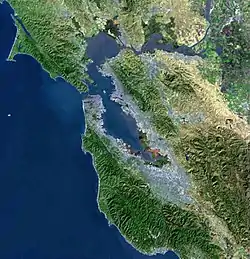Mare Island Naval Shipyard | |
_at_the_Mare_Island_Naval_Shipyard%252C_California_(USA)%252C_on_10_April_1945_(NH_98906).jpg.webp) USS Wadleigh at Mare Island Naval Yard, 10 April 1945. | |
  | |
| Location | Vallejo, California |
|---|---|
| Coordinates | 38°5′24″N 122°15′48″W / 38.09000°N 122.26333°W |
| Built | 1854 |
| NRHP reference No. | 75002103[2] |
| CHISL No. | 751[1] |
| Significant dates | |
| Added to NRHP | 15 May 1975 |
| Designated NHLD | 15 May 1975[3] |
| Designated CHISL | 1960 |
The Mare Island Naval Shipyard (MINSY) was the first United States Navy base established on the Pacific Ocean.[4] It is located 25 miles (40 km) northeast of San Francisco in Vallejo, California. The Napa River goes through the Mare Island Strait and separates the peninsula shipyard (Mare Island, California) from the main portion of the city of Vallejo. MINSY made a name for itself as the premier U.S. West Coast submarine port as well as serving as the controlling force in San Francisco Bay Area shipbuilding efforts during World War II.[5]
The base closed in 1996 and has gone through several redevelopment phases. It was registered as a California Historical Landmark in 1960,[1] and parts of it were declared a National Historic Landmark District in 1975.[3]
Beginnings
In September 1849, Lieutenant Commander William Pope McArthur was placed in command of the US survey schooner Ewing, which had been brought around Cape Horn to the West Coast by Lieutenant Washington Allon Bartlett.[6] Upon reaching San Francisco, Ewing and the other ship assigned to the survey, USS Massachusetts, were hampered from progress due to desertions of their crews to the gold fields, including a mutiny when crew members rowing into the city from Ewing threw an officer overboard in an attempt to desert.[7] They managed to survey the Mare Island Strait[6] before steaming to Hawaii to obtain crewmen from Hawaiian monarch King Kamehameha III.[8] They returned to San Francisco in the spring of 1850 with the coastal survey of northern California beginning on 4 April 1850 and continued up to the mouth of the Columbia River. On 1 August 1850, while still in Oregon, McArthur purchased a 1⁄16 interest in Mare Island for $468.50[6] then returned to San Francisco later that month to prepare charts and write reports.
On 15 January 1852, Secretary of the Navy William A. Graham ordered a Naval Commission to select a site for a naval yard on the Pacific Coast. Commodore D. Sloat along with Commodore C. Ringgold, Simon F. Blunt and William P.S. Sanger (former overseer of construction of Drydock Number One, Norfolk Naval Shipyard) were appointed to the commission. On 13 July 1852, Sloat recommended the island[9] across the Napa River from the settlement of Vallejo.
The Navy purchased the original 956 acres (387 ha) of MINSY on 4 January 1853. McArthur's family share (he had died a few months after purchasing an interest in Mare Island) was $5,218.20.[6] The Navy commenced shipbuilding operations on 16 September 1854 under the command of then-Commander David Farragut, who later gained fame during the U.S. Civil War Battle of Mobile Bay, when he gave the order, "Damn the torpedoes, full speed ahead!" MINSY served as a major Pacific Ocean repair station during the late 19th century, handling American as well as Japanese and Russian vessels in the course of duty.
In 1861, the longest lived of the clipper ships, Syren, was brought to Mare Island Navy Yard for $15,000 of repairs. Syren had struck Mile Rock twice while trying to sail out of the Golden Gate.[10]
Marines first arrived for duty in 1862 under the command of Maj Addison Garland, who was the first officer to command the Marine barracks on the island.
Mare Island Naval Shipyard also took a commanding role in civil defense and emergency response on the West Coast, dispatching warships to the Pacific Northwest to subdue Native American unrest. MINSY sent ships such as Wyoming south to Central America and the Panama Canal to protect US political and commercial interests. Some of the support, logistics and munition requirements for the Spanish–American War were filled by Mare Island. MINSY sent men, materiel and ships to San Francisco in response to the fires following the 1906 earthquake. Arctic rescue missions were mounted as necessary. Ordnance manufacturing and storage were two further key missions at MINSY for nearly all of its active service, including ordnance used prior to the American Civil War.[11]
In 1911, the Marine Corps established two West Coast recruit training depots first at Mare Island, the second at Puget Sound, Washington. Mare Island eventually became the West Coast's only recruit training facility when the Puget Sound operation consolidated to the San Francisco Bay Area in 1912. Instructors trained recruits there until 10 August 1923, when they relocated to the Marine Corps Recruit Depot San Diego.[12] The Marine Barracks Mare Island remained.
World War I
In July 1917, MINSY was the site of a major explosion that killed six people. On July 9, a gunpowder magazine containing 127,600 pounds of black powder blew up, damaging a number of surrounding buildings, and leaving a mystery as to what had caused it. Suspicion settled on an identified German agent and possible saboteur, Lothar Witzke, but the investigation proved inconclusive and the official verdict was that the cause was unknown. Stephen C. Ruder has suggested in a 2022 article that it may not have been an act of German sabotage but suicide by a civilian, Neil Damstedt, who was the principal victim and only individual inside the magazine at the moment of explosion.[13][14]
MINSY saw major shipbuilding efforts during World War I. MINSY holds a shipbuilding speed record for a destroyer that still stands, launching USS Ward in just 17+1⁄2 days in May–June 1918.[15] Mare Island was selected by the Navy for construction of the only US West Coast-built dreadnought battleship, USS California, launched in 1919. Several pre-dreadnought battleships had previously been launched at San Francisco and Seattle. Noting the power of underwater warfare shown by German U-boats in World War I, the Navy doubled their Pacific-based submarine construction program at Puget Sound Naval Shipyard by founding a submarine program at MINSY in the early 1920s.[16]
Mare Island Marines Football Team
During this period, the Marines stationed at MINSY fielded a college football team which competed against teams in the Pacific Coast Conference and other military service football teams. After the United States entered WWI during April 1917, many college athletes joined or were drafted into the military. Enrolments diminished at universities around the country, with many schools cutting back their sports programs as a result. Consequently, military academies and training bases established football teams composed mostly of college players who had been recruited for service. This was further encouraged by officials who considered football to be excellent war training, with its themes of leadership, teamwork, and discipline.[17] The 1917 Mare Island Marines football team strung together an impressive first season, going 8–0, shutting out six opponents, winning the 1918 Rose Bowl against the Camp Lewis 91st Division football team, and outscoring all of their opponents by a combined total of 200 to 10. This was despite only 500 Marines being stationed at the base when the team was formed.[18] The 1918 Mare Island Marines football team fielded an entirely new roster, which achieved a similar level of success as the previous year. They finished the season with a 10–1 record, losing only in the 1919 Rose Bowl to the Great Lakes Navy Bluejackets.
World War II
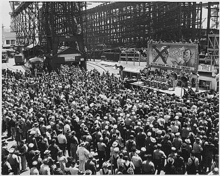
Base facilities included a hospital, ammunition depot, paint and rubber testing laboratories, and schools for firefighters, opticians, and anti-submarine attack during World War II.[19] MINSY reached peak capacity for shipbuilding, repair, overhaul, and maintenance of many different kinds of seagoing vessels including both surface combatants and submarines.
Up to 50,000 workers were employed.[20] Mare Island even received Royal Navy cruisers and destroyers and four Soviet Navy subs for service.[5] Following the War, MINSY was considered to be one of the primary stations for construction and maintenance of the Navy's Pacific fleet of submarines, having built seventeen submarines and four submarine tenders by the end of hostilities.
Before World War II the Navy established Station I at Mare Island as one of four High Frequency Direction Finding (HFDF) stations on the Pacific mainland to track Japanese naval and merchant shipping east of Hawaii. The other stations were: Point Arguello, California (Station Z), Point Saint George, California (Station T), and Fort Stevens, Oregon (Station S).
War bonds
Patriotism and esprit de corps among the workers ran very high. Mare Island's military and civilian workforce raised almost $76M in war bonds; enough to pay for every one of the submarines built at MINSY prior to VJ Day. More than 300 landing craft were built at Mare Island.[21][22]
Dry docks and slipways
| Dock No. | Material of which dock is constructed | Length | Width | Depth | Date Completed | Source |
|---|---|---|---|---|---|---|
| 1 | Concrete and granite | 525 feet (160 m) | 122 feet (37 m) | 35 feet 9 inches (10.90 m) | 1891 | [23] |
| 2 | Concrete | 741 feet (226 m) | 120 feet (37 m) | 31 feet 2 inches (9.50 m) | 1910 | |
| 3 | Concrete | 693 feet 4 inches (211.33 m) | 114 feet (35 m) | 35 feet 9 inches (10.90 m) | 1940 | |
| 4 | Concrete | 435 feet 8 inches (132.79 m) | 104 feet (32 m) | 22 feet 8 inches (6.91 m) | 1942 |
| January 1, 1946 | |||
|---|---|---|---|
| Shipbuilding ways | Width | Length | Source |
| 1 | 108 feet 8 inches (33.12 m) | 680 feet (210 m) | [24] |
| 2 | 89 feet (27 m) | 398 feet (121 m) | |
| 308 feet (94 m) | |||
| 3 | 93 feet (28 m) | 488 feet (149 m) | |
| 4 | 96 feet (29 m) | 450 feet (140 m) | |
| 5 | 96 feet (29 m) | 450 feet (140 m) | |
| 6 | 96 feet (29 m) | 450 feet (140 m) | |
| 7 | 96 feet (29 m) | 450 feet (140 m) | |
| 8 | 96 feet (29 m) | 450 feet (140 m) | |
Shipbuilding
Mare Island Naval Shipyard constructed at least eighty-nine seagoing vessels. Among the more important ships & boats built were:
_and_USS_Somers_(DD-301)_underway_off_San_Diego%252C_in_1928_(NH_81279).jpg.webp)
_off_the_Mare_Island_Naval_Shipyard%252C_California_(USA)%252C_2_December_1943_(NH_42273).jpg.webp)
- 1858 USS Saginaw – sloop-of-war, wood
- 1872 USS Mohican – sloop-of-war, wood
- 1874 USC&GS McArthur – Steamer
- 1875 USS Monadnock – monitor, steel
- 1886 USRC Cosmos – Revenue Cutter, wood
- 1904 USS Intrepid – training ship, steel barque
- 1907 USS Prometheus – collier, steel
- 1911 USS Jupiter – collier, steel. Later converted to aircraft carrier USS Langley
- 1913 USS Kanawha – tanker, steel
- 1913 USRC Guard – Revenue Cutter Service harbor tug, wood[25]
- 1913 USS Palos – gunboat, steel
- 1913 USS Monocacy – gunboat, steel
- 1914 USS Maumee – tanker, steel
- 1915 USS Cuyama – tanker, steel
- 1916 USS Shaw, destroyer – steel
- 1916 USS California – battleship, steel
- 1916 USS Caldwell – destroyer, steel
- 1917 Fifteen submarine chasers – wood
- 1917 USS Fairfax – destroyer – (Destroyers for Bases Agreement)[26]
- 1917 USS Taylor – destroyer
- 1918 USS Boggs – destroyer – (World War II)
- 1918 USS Kilty – destroyer – (Guadalcanal campaign – Philippines campaign (1944–45) – Battle of Okinawa)
- 1919 USS Kennison – destroyer – (World War II)
- 1918 USS Ward – destroyer – (attack on Pearl Harbor – Guadalcanal campaign – Philippines campaign)
- 1918 USS Claxton – destroyer[26]
- 1919 USS Hamilton – destroyer – (invasion of North Africa – Philippines campaign)
- 1920 USS Montana – battleship scrapped before completion under terms of the Washington Naval Treaty
- 1920 USS Litchfield – destroyer – (World War II)
- 1920 USS Zane – destroyer – (attack on Pearl Harbor – Guadalcanal campaign)
- 1921 USS Wasmuth – destroyer – (attack on Pearl Harbor)
- 1922 USS Trever – destroyer – (attack on Pearl Harbor – Guadalcanal campaign)
- 1922 USS Perry – destroyer – (attack on Pearl Harbor – Battle of Peleliu)
- 1922 USS Decatur – destroyer – (World War II)
- 1927 USS Nautilus – submarine (sank 6 ships in 14 World War II Pacific patrols)[27]
- 1 of 6 Northampton-class heavy cruisers
- 1 of 7 New Orleans-class heavy cruisers
- 1931 USS San Francisco – (attack on Pearl Harbor – Battle of Cape Esperance – Naval Battle of Guadalcanal – Battle of the Philippine Sea[28] – Philippines campaign (1944–45) – Battle of Okinawa)
- 2 of 18 Mahan-class destroyers
- 1934 USS Smith – (Battle of the Santa Cruz Islands – Philippines campaign)
- 1934 USS Preston – (Battle of the Santa Cruz Islands – Naval Battle of Guadalcanal)
- 1 of 8 Bagley-class destroyers
- 1935 USS Henley – (attack on Pearl Harbor – Guadalcanal campaign)
- 31 of 65 Evarts-class destroyer escorts
- 1942 USS Brennan (DE-13)
- ...
- 1943 USS Manlove (DE-36)
- 1943 USS Lake (DE-301)
- ...
- 1944 USS Finnegan (DE-307)
With the prelude to, and the outbreak of World War II, the Mare Island Naval Shipyard specialized in submarines, and other than a few submarine tenders and destroyer escorts, no more surface ships were built there. MINSY continued building non-nuclear subs through the Cold War including two of the three Barracuda-class submarines and USS Grayback, an early guided missile launcher. In 1955, Mare Island was awarded the contract to build Sargo, the first nuclear submarine laid down at a Pacific base.
The shipyard became one of the few that built and overhauled nuclear submarines, including several UGM-27 Polaris submarines. 1970 saw the launching of Drum, the last nuclear submarine built in California. In 1972, the Navy officially ceased building new nuclear submarines at Mare Island, though overhaul of existing vessels continued. Nautilus was decommissioned at Mare Island in 1980, then rigged for towing back to Groton, Connecticut, to serve as a museum of naval history.[29]
- 1 of 10 United States Porpoise-class submarines
- 1936 USS Pompano – sank 6 ships in 7 World War II Pacific patrols[30]
- 1 of 6 Salmon-class submarines
- 1936 USS Sturgeon – sank 9 ships in 11 World War II Pacific patrols[31]
- 1 of 10 Sargo-class submarines
- 1937 USS Swordfish – sank 12 ships in 13 World War II Pacific patrols[32]
- 1939 USS Fulton – submarine tender – (World War II)
- 2 of 12 Tambor-class submarines
- 1939 USS Tuna – sank 4 ships in 13 World War II Pacific patrols[33]
- 1939 USS Gudgeon – sank 11 ships in 12 World War II Pacific patrols[34]
- 1941 USS Sperry – submarine tender[35] – (World War II)
- 1942 USS Bushnell – submarine tender[35] – (World War II)
- 8 of 77 Gato-class submarines
- 1941 USS Silversides – [36] (sank 23 ships in 14 World War II Pacific patrols (3rd highest number for a U.S. submarine)[37]
- 1941 USS Trigger – [36] (sank 18 ships in 12 World War II Pacific patrols (11th highest number for a U.S. submarine)[38]
- 1942 USS Wahoo – [39] (sank 20 ships in 7 World War II Pacific patrols (6th highest number for a U.S. submarine)[40]
- 1942 USS Whale – [39] (sank 9 ships in 11 World War II Pacific patrols[41]
- 1942 USS Sunfish – [39] (sank 15 ships in 11 World War II Pacific patrols[27]
- 1942 USS Tunny – [39] (sank 7 ships in 9 World War II Pacific patrols[42] Vietnam War)
- 1942 USS Tinosa – submarine[39] (sank 16 ships in 11 World War II Pacific patrols[42]
- 1942 USS Tullibee – [39] (sank 3 ships 4 World War II Pacific patrols[43]
- 1943 USS Howard W. Gilmore – submarine tender[35] – (World War II)
- 10 of 120 Balao-class submarines
- 1943 USS Seahorse – [44] (sank 20 ships in 8 World War II Pacific patrols (6th highest number for a U.S. submarine)[45]
- 1943 USS Skate – [44] (sank 10 ships in 7 World War II Pacific patrols[42]
- 1943 USS Tang – [44] (sank 24 ships in 5 World War II Pacific patrols (highest number for a U.S. submarine)[46]
- 1943 USS Tilefish – [44] (sank 2 ships 6 World War II Pacific patrols[47]
- 1944 USS Spadefish – [48] (sank 21 ships in 5 World War II Pacific patrols (4th highest number for a U.S. submarine)[37]
- 1944 USS Trepang – [48] (sank 11 ships in 5 World War II Pacific patrols[41]
- 1944 USS Spot – [48] (sank 1 ship in 3 World War II Pacific patrols[41]
- 1944 USS Springer – [48] (sank 4 ships in 3 World War II Pacific patrols[41]
- 1945 USS Stickleback – [48] (1 World War II Pacific patrol[47])
- 1947 USS Tiru – [48]
- 1945 USS Nereus – submarine tender[35]
- 2 of 3 United States Barracuda-class submarines
- 1951 USS Bass
- 1951 USS Bonita
- 1 of 2 Grayback-class submarines
- 1957 USS Grayback – [49]

- 1957 USS Sargo – submarine (nuclear powered) [50]
- 1959 USS Halibut – submarine (nuclear powered) [51]
- 1959 USS Theodore Roosevelt – submarine (nuclear powered) [52]
- 1960 USS Scamp – submarine (nuclear powered) [53]
- 1961 USS Permit – submarine (nuclear powered) [54]
- 1961 USS Plunger – submarine (nuclear powered) [54]
- 1962 USS Andrew Jackson – submarine (nuclear powered) [55]
- 1963 USS Woodrow Wilson – submarine (nuclear powered) [55]
- 1963 USS Daniel Boone – submarine (nuclear powered) [55]
- 1963 USS Stonewall Jackson – submarine (nuclear powered) [55]
- 1964 Trieste II – deep submergence bathyscaphe
- 1965 USS Kamehameha – submarine (nuclear powered) [55]
- 1965 USS Mariano G. Vallejo - submarine (nuclear powered) [55]
- 1967 USS Gurnard – submarine (nuclear powered) [56]
- 1968 USS Guitarro – submarine (nuclear powered) [56]
- 1969 USS Hawkbill – submarine (nuclear powered) [56]
- 1969 USS Pintado – submarine (nuclear powered) [56]
- 1970 USS Drum – submarine (nuclear powered) [56]
Riverine training
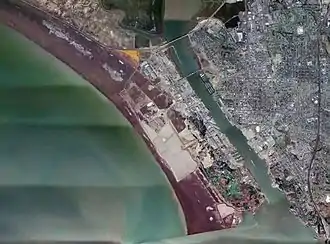
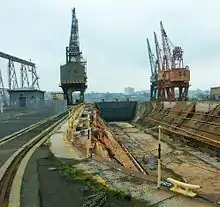
In 1966, during the Vietnam War, the U.S. Navy transferred their Brown Water Navy Riverine Training Operations from Coronado, California, to Mare Island. Motorists traveling along Highway 37 could often see U.S. Navy River Patrol Boats, among other river assault type boats, maneuvering through the sloughs of what is now the Napa-Sonoma State Wildlife Area, which borders the north and west portions of Mare Island.
U.S. Navy Reserve Units may still operate the slough portions of the State Wildlife Area for training purposes, as the navigable waters are considered public property. The U.S. Navy Brown Water Riverine Forces were inactivated after the Vietnam War, maintaining only the U.S. Naval Reserve PBRs and auxiliary craft at Mare Island, until the 1996 base closure.
U.S. Naval Construction Battalion Unit 421
Mare Island was also home to the Seabees CBU 421 who completed many construction projects in the bay area including renovation and restoration of St. Peter's chapel. St. Peter's is the oldest Navy Chapel in the United States built in 1901.
Pacific Reserve Fleet, Mare Island
Pacific Reserve Fleet, Mare Island was a large US reserve fleet that opened in 1946 to store the many surplus ships after World War II. As part of the United States Navy reserve fleets, the fleet "mothballed" ships and submarines. Some ships in the fleet were reactivated for the Korean War and Vietnam War.[57][58] The Reserve Fleet closed in 1996 with the shipyard. The ships were scrapped or moved to other reserve fleets.[59][60]
Base closure
Mare Island Naval Shipyard expanded to over 5,200 acres (2,104 ha) during its service life and was responsible for construction of over 500 naval vessels and overhauling thousands of other vessels. Though it remained a strong contender for continued operations, MINSY was identified for closure during the Base Realignment and Closure (BRAC) process of 1993. Naval operations ceased and the facility was decommissioned on 1 April 1996.
The California Conservation Corps, Touro University California, and numerous commercial and industrial businesses are currently leasing property aboard the former naval shipyard. In May 2000, the Navy completed the transfer of a former housing area called Roosevelt Terrace using an "economic development conveyance"; a method to accelerate the transfer of BRAC facilities back to civilian communities for their economic benefit. The Navy is also transferring property at the shipyard to other government agencies such as Fish and Wildlife Service refuge, a Forest Service office building, an Army Reserve Center, a Coast Guard communications facility, and a Department of Education school.
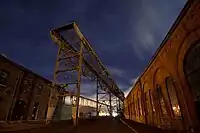 Entrance to The Mare Island Naval Shipyard Industrial Area, April 2011
Entrance to The Mare Island Naval Shipyard Industrial Area, April 2011 The Mare Island Naval Shipyard facility, April 2011
The Mare Island Naval Shipyard facility, April 2011
Appearances in popular culture
The shipyard was featured by Huell Howser in California's Gold Episode 704.[61]
See also
- Rosie the Riveter/World War II Home Front National Historical Park
- California during World War II
- California Historical Landmarks in Solano County
References
Notes
- 1 2 3 "First U.S. Naval Station in the Pacific". Office of Historic Preservation, California State Parks. Retrieved 15 October 2012.
- ↑ "National Register Information System". National Register of Historic Places. National Park Service. 15 April 2008.
- 1 2 "Mare Island Naval Shipyard". National Historic Landmarks Quioklinks. National Park Service. Archived from the original on 8 October 2012. Retrieved 18 March 2012.
- ↑ Adams, George R. (1 December 1974). "Mare Island Naval Shipyard" (pdf). National Register of Historic Places – Inventory Nomination Form. National Park Service. Retrieved 18 May 2012.
- 1 2 Battleship Iowa: Mare Island
- 1 2 3 4 "The Frontier Coast". NOAA Central Library. 30 November 2007. Archived from the original on 25 February 2016.
- ↑ Gudde, Erwin G. "Mutiny on the Ewing". Retrieved 2 January 2008. Originally published in The JOURNAL, Coast and Geodetic Survey, 1951-12-01, Number 4
- ↑ McArthur, Lewis Pacific Coast Survey of 1849 and 1850 Private history 1915 NOAA.gov retrieved 26 December 2007
- ↑ "Mare Island Navy Yard". Overland Monthly. 1908. pp. 411–12.
- ↑ Howe, Octavius T; Matthews, Frederick C. (1927). American Clipper Ships 1833–1858. Vol. 2, Malay-Young Mechanic. Salem, MA: Marine Research Society. pp. 653–656.
- ↑ Lott, A Long Line of Ships, pages 3–134.
- ↑ Mare Island was first California boot camp
- ↑ Stephen C. Ruder, "Who Really Blew Up Mare Island?" Naval History (June 2022): 40-45.
- ↑ Spencer Tucker and Priscilla Mary Roberts, ed. World War One: A Student Encyclopedia (ABC-Clio, 2005): 1606
- ↑ Mare Island History. Vallejo Convention & Visitors Bureau website. Accessed 22 August 2007
- ↑ Lott, A Long Line of Ships, pp. 161–180.
- ↑ "Camp Lewis 91st Division football team plays the Mare Island Marines in the Rose Bowl on January 1, 1918. - HistoryLink.org". www.historylink.org. Retrieved 22 October 2023.
- ↑ Brown, Timothy P. "1917 Mare Island Marines Football Team". www.footballarchaeology.com. Retrieved 22 October 2023.
- ↑ "U.S. Naval Activities World War II by State". Patrick Clancey. Retrieved 19 March 2012.
- ↑ Kern, James & Vallejo and Naval Historical Museum Images of America: Vallejo. Arcadia Publishing, 2004.
- ↑ FAS Military Analysis Network: Mare Island Naval Shipyard (MINSY)
- ↑ Lott, A Long Line of Ships, pp. 209–237.
- ↑ "Drydocking Facilities Characteristics" (PDF).
- ↑ Gardiner Fassett, Frederick, The Shipbuilding Business in the United States of America, p. 177
- ↑ Cutters, Craft & Coast Guard-Manned Army & Navy Vessels
- 1 2 Fahey, The Ships and Aircraft of the U.S. Fleet, p. 17
- 1 2 Blair, Silent Victory Vol. 2, p. 945
- ↑ Tillman(2005)pp. 301–306
- ↑ Chief of Naval Operations, Submarine Warfare Division: Submarine Chronology Archived 10 July 2007 at the Wayback Machine
- ↑ Blair, Silent Victory Vol. 2, p. 907
- ↑ Blair, Silent Victory Vol. 2, p. 926
- ↑ Blair, Silent Victory Vol. 2, p. 939
- ↑ Blair, Silent Victory Vol. 2, p. 946
- ↑ Blair, Silent Victory Vol. 2, p. 919
- 1 2 3 4 Silverstone, U.S. Warships of World War II, p. 287
- 1 2 Silverstone, U.S. Warships of World War II, p. 195
- 1 2 Blair, Silent Victory Vol. 2, pp. 953υ
- ↑ Blair, Silent Victory Vol. 2, pp. 945υ
- 1 2 3 4 5 6 Silverstone, U.S. Warships of World War II, p. 197
- ↑ Blair, Silent Victory Vol. 2, pp. 913υ
- 1 2 3 4 Blair, Silent Victory Vol. 2, p.954
- 1 2 3 Blair, Silent Victory Vol. 2, p. 953
- ↑ Blair, Silent Victory Vol. 2, p. 918
- 1 2 3 4 Silverstone, U.S. Warships of World War II, p. 199
- ↑ Blair, Silent Victory Vol. 2, p. 956
- ↑ Blair, Silent Victory Vol. 2, pp. 933υ
- 1 2 Blair, Silent Victory Vol. 2, p. 957
- 1 2 3 4 5 6 Silverstone, U.S. Warships of World War II, p. 203
- ↑ Blackman Jane's 1970–71, p. 473
- ↑ Blackman Jane's 1970–71, p. 472
- ↑ Blackman Jane's 1970–71, p. 470
- ↑ Blackman Jane's 1970–71, p. 406
- ↑ Blackman Jane's 1970–71, p. 469
- 1 2 Blackman Jane's 1970–71, p. 468
- 1 2 3 4 5 6 Blackman Jane's 1970–71, p. 403
- 1 2 3 4 5 Blackman Jane's 1970–71, p. 466
- ↑ YouTube, The Mothball Fleet
- ↑ youtube.com The USN Mothball Fleet - Storing up for a rainy day
- ↑ ww2db.com Pacific Reserve Fleet, Mare Island
- ↑ US Navy Pacific Reserve Fleet, Mare Island
- ↑ "Mare Island – California's Gold (704) – Huell Howser Archives at Chapman University".
Bibliography
- Blackman, Raymond V.B. Jane's Fighting Ships 1970–71. London: Jane's Yearbooks.
- Gardiner Fassett, Frederick (1 January 1948). The Shipbuilding Business in the United States of America. Society of Naval Architects and Marine Engineers.
- Lott, Arnold S., Lt. Comdr., U.S.N. A Long Line of Ships: Mare Island's Century of Naval Activity in California. Annapolis: United States Naval Institute, 1954.
- Silverstone, Paul H., U.S. Warships of World War II. New York: Doubleday & Company, 1968.
- Steffes, James, ENC Retired. Swift Boat Down: The Real Story of the Sinking of PCF-19. (2006); ISBN 1-59926-612-1.
- Tillman, Barrett Clash of the Carriers. New York: New American Library, 2005. ISBN 978-0-451-21956-5.
- 1941 Society of Naval Architects Bulletin, Harold W. Linnehan, writing as a visitor from Design section, Mare Island, California.
External links
- Brief history written in 1939
- Recently written history with photos
- Mare Island Navy Yard – 1928. Elbridge Ayer Burbank pencil sketch.
- National Park Service World War II in the San Francisco Bay Area: Mare Island Naval Shipyard
- Mare Island Historic Park Foundation
- Darryl Manzer. "Straightening Nails: A Story of Reuse and Renewal". Santa Clarita Valley Historical Society. Retrieved 20 February 2005.
- "Mare Island Naval Shipyard" (pdf). Photographs. National Park Service. Retrieved 18 May 2012.
- Historic American Engineering Record (HAER) No. CA-3, "Mare Island Naval Shipyard, Near State Highway 37, Vallejo, Solano County, CA", 9 photos, 2 data pages, 1 photo caption page
- HAER No. CA-3-A, "Mare Island Naval Shipyard, Structural Shop", 10 photos, 14 measured drawings, 4 data pages, 1 photo caption page
- HAER No. CA-3-B, "Mare Island Naval Shipyard, Pattern Shop", 12 photos, 3 data pages, 1 photo caption page
- HAER No. CA-3-C, "Mare Island Naval Shipyard, Sail Loft", 8 photos, 3 data pages, 1 photo caption page
- St.Peter's Chapel "http://www.mareislandmuseum.org/venues/st-peters-chapel/"

_-_NH_82114.jpg.webp)
_enters_San_Francisco_Bay%252C_December_1942.jpg.webp)
